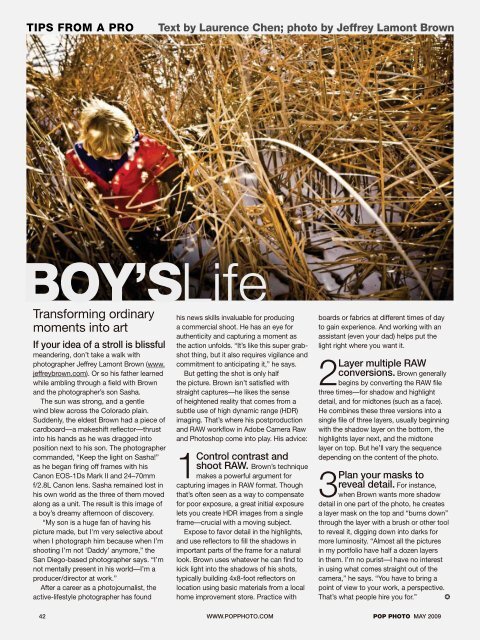NEW - Ken Gilbert
NEW - Ken Gilbert
NEW - Ken Gilbert
You also want an ePaper? Increase the reach of your titles
YUMPU automatically turns print PDFs into web optimized ePapers that Google loves.
TIPS FROM A PRO<br />
BOY ‚ SLife<br />
Transforming ordinary<br />
moments into art<br />
If your idea of a stroll is blissful<br />
meandering, don’t take a walk with<br />
photographer Jeffrey Lamont Brown (www.<br />
jeffreybrown.com). Or so his father learned<br />
while ambling through a fi eld with Brown<br />
and the photographer’s son Sasha.<br />
The sun was strong, and a gentle<br />
wind blew across the Colorado plain.<br />
Suddenly, the eldest Brown had a piece of<br />
cardboard—a makeshift refl ector—thrust<br />
into his hands as he was dragged into<br />
position next to his son. The photographer<br />
commanded, “Keep the light on Sasha!”<br />
as he began fi ring off frames with his<br />
Canon EOS-1Ds Mark II and 24–70mm<br />
f/2.8L Canon lens. Sasha remained lost in<br />
his own world as the three of them moved<br />
along as a unit. The result is this image of<br />
a boy’s dreamy afternoon of discovery.<br />
“My son is a huge fan of having his<br />
picture made, but I'm very selective about<br />
when I photograph him because when I’m<br />
shooting I’m not ‘Daddy’ anymore,” the<br />
San Diego-based photographer says. “I’m<br />
not mentally present in his world—I’m a<br />
producer/director at work.”<br />
After a career as a photojournalist, the<br />
active-lifestyle photographer has found<br />
Text by Laurence Chen; photo by Jeffrey Lamont Brown<br />
his news skills invaluable for producing<br />
a commercial shoot. He has an eye for<br />
authenticity and capturing a moment as<br />
the action unfolds. “It’s like this super grabshot<br />
thing, but it also requires vigilance and<br />
commitment to anticipating it,” he says.<br />
But getting the shot is only half<br />
the picture. Brown isn’t satisfi ed with<br />
straight captures—he likes the sense<br />
of heightened reality that comes from a<br />
subtle use of high dynamic range (HDR)<br />
imaging. That’s where his postproduction<br />
and RAW workfl ow in Adobe Camera Raw<br />
and Photoshop come into play. His advice:<br />
1<br />
Control contrast and<br />
shoot RAW. Brown’s technique<br />
makes a powerful argument for<br />
capturing images in RAW format. Though<br />
that’s often seen as a way to compensate<br />
for poor exposure, a great initial exposure<br />
lets you create HDR images from a single<br />
frame—crucial with a moving subject.<br />
Expose to favor detail in the highlights,<br />
and use refl ectors to fi ll the shadows in<br />
important parts of the frame for a natural<br />
look. Brown uses whatever he can fi nd to<br />
kick light into the shadows of his shots,<br />
typically building 4x8-foot refl ectors on<br />
location using basic materials from a local<br />
home improvement store. Practice with<br />
boards or fabrics at different times of day<br />
to gain experience. And working with an<br />
assistant (even your dad) helps put the<br />
light right where you want it.<br />
2<br />
Layer multiple RAW<br />
conversions. Brown generally<br />
begins by converting the RAW fi le<br />
three times—for shadow and highlight<br />
detail, and for midtones (such as a face).<br />
He combines these three versions into a<br />
single fi le of three layers, usually beginning<br />
with the shadow layer on the bottom, the<br />
highlights layer next, and the midtone<br />
layer on top. But he’ll vary the sequence<br />
depending on the content of the photo.<br />
3 Plan your masks to<br />
reveal detail. For instance,<br />
when Brown wants more shadow<br />
detail in one part of the photo, he creates<br />
a layer mask on the top and “burns down”<br />
through the layer with a brush or other tool<br />
to reveal it, digging down into darks for<br />
more luminosity. “Almost all the pictures<br />
in my portfolio have half a dozen layers<br />
in them. I’m no purist—I have no interest<br />
in using what comes straight out of the<br />
camera,” he says. “You have to bring a<br />
point of view to your work, a perspective.<br />
That’s what people hire you for.” p<br />
42 WWW.POPPHOTO.COM POP PHOTO MAY 2009

















